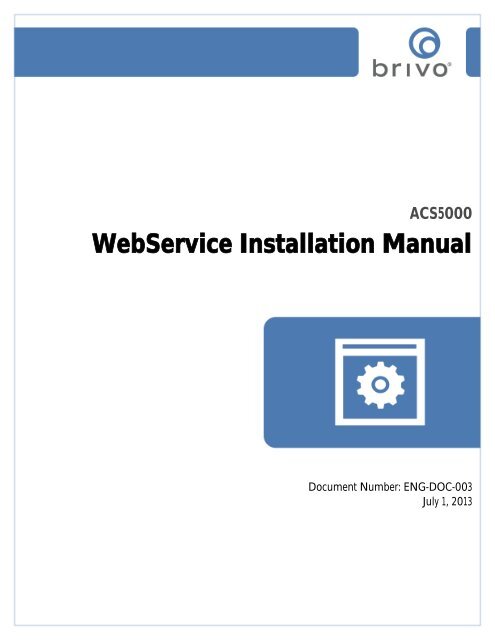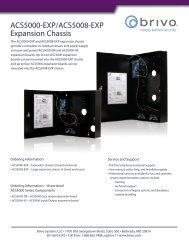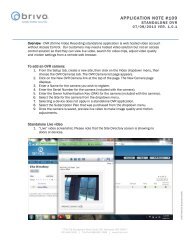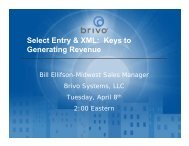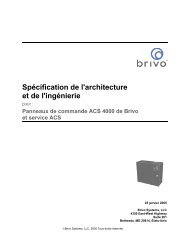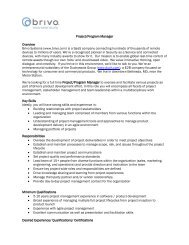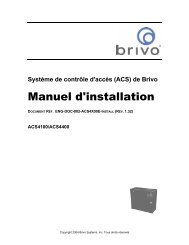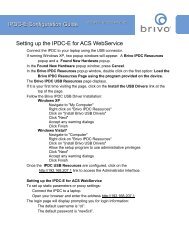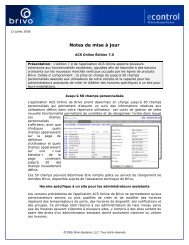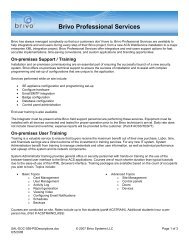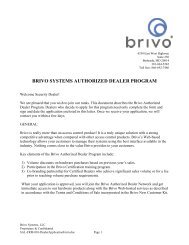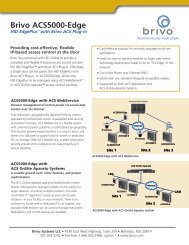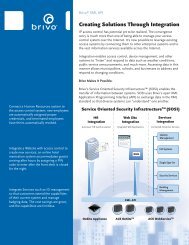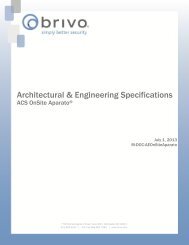ACS5000-E/W Installation Manual - Brivo Systems
ACS5000-E/W Installation Manual - Brivo Systems
ACS5000-E/W Installation Manual - Brivo Systems
Create successful ePaper yourself
Turn your PDF publications into a flip-book with our unique Google optimized e-Paper software.
<strong>ACS5000</strong><br />
WebService <strong>Installation</strong> <strong>Manual</strong><br />
Document Number: ENG-DOC-003<br />
July 1, 2013
Legal Disclaimers<br />
Federal Communications Commission (FCC) Compliancy<br />
This equipment has been tested and found to comply with the limits for a Class B digital device, pursuant to<br />
Part 15 of the FCC Rules. These limits are designed to provide reasonable protection against harmful<br />
interference in a residential installation or when the equipment is operated in a commercial environment.<br />
This equipment generates, uses and can radiate radio frequency energy and, if not installed and used in<br />
accordance with the instruction manual, may cause harmful interference to radio communications.<br />
However, there is no guarantee that interference will not occur in a particular installation. If this equipment<br />
does cause harmful interference to radio or television reception, which can be determined by turning the<br />
equipment off and on, the user is encouraged to try to correct the interference by one or more of the<br />
following measures:<br />
<br />
<br />
<br />
<br />
Re-orient or relocate the receiving antenna (wireless models only).<br />
Increase the distance between the equipment and receiver.<br />
Connect the equipment to a circuit other than the one to which the receiver is connected.<br />
Consult the dealer for help.<br />
Canada-Underwriters Laboratories (C-UL) Compliancy<br />
For C-UL Listed applications, the unit shall be installed in accordance with Part 1 of the Canadian Electrical<br />
Code.<br />
<strong>ACS5000</strong>-G Wireless Modem Feature<br />
The wireless modem for the <strong>ACS5000</strong>-G is a supplementary feature only.<br />
Documentation Disclaimer and Restrictions<br />
Information in this document is subject to change without notice and does not represent a commitment on<br />
the part of <strong>Brivo</strong> <strong>Systems</strong>, LLC. For the most up-to-date information, visit www.brivo.com and click Dealer<br />
Login to gain access to the Extranet.<br />
This document and the data herein shall not be duplicated, used or disclosed to others for procurement or<br />
manufacturing, except as authorized with the written permission of <strong>Brivo</strong> <strong>Systems</strong>, LLC. The information<br />
contained within this document or within the product itself is considered the exclusive property of <strong>Brivo</strong><br />
<strong>Systems</strong>, LLC. All information in this document or within the hardware and software product themselves is<br />
protected by the copyright and/or other intellectual property laws of the United States.<br />
Activation of Services Agreement<br />
Any use of this product is subject to the activation of the <strong>Brivo</strong> <strong>Systems</strong> Services Agreement. Please request<br />
a copy from <strong>Brivo</strong> <strong>Systems</strong>, LLC. and review this agreement carefully.<br />
© 2013 <strong>Brivo</strong> <strong>Systems</strong>, LLC. All rights reserved.<br />
<strong>Brivo</strong>® is a registered trademark of <strong>Brivo</strong> <strong>Systems</strong>, LLC. <strong>Brivo</strong> <strong>Systems</strong>, LLC, 7700 Old Georgetown Road,<br />
Suite 300, Bethesda, MD 20814
<strong>ACS5000</strong> Page 3<br />
© 2013 <strong>Brivo</strong> <strong>Systems</strong>, LLC. All rights reserved. 7/1/2013
Page 4<br />
<strong>Installation</strong> <strong>Manual</strong><br />
Table of Contents<br />
LEGAL DISCLAIMERS .................................................................................................................................... 2<br />
FEDERAL COMMUNICATIONS COMMISSION (FCC) COMPLIANCY ................................................................................... 2<br />
CANADA-UNDERWRITERS LABORATORIES (C-UL) COMPLIANCY ..................................................................................... 2<br />
DOCUMENTATION DISCLAIMER AND RESTRICTIONS ...................................................................................................... 2<br />
ACTIVATION OF SERVICES AGREEMENT ......................................................................................................................... 2<br />
TABLE OF CONTENTS .................................................................................................................................. 4<br />
INTRODUCTION ........................................................................................................................................... 6<br />
DOCUMENT OBJECTIVES .............................................................................................................................................. 6<br />
DOCUMENT LAYOUT ................................................................................................................................................... 6<br />
TERMINOLOGY ............................................................................................................................................................ 6<br />
ADDITIONAL RESOURCES ............................................................................................................................................. 6<br />
PRE-INSTALLATION PROCEDURES ............................................................................................................. 8<br />
UNDERSTAND THE FUNCTION OF THE BRIVO <strong>ACS5000</strong>. ............................................................................................... 8<br />
UNDERSTAND BRIVO <strong>ACS5000</strong> PRODUCT COMPATIBILITY. ............................................................................................ 8<br />
VERIFY THAT THE CLIENT SITE IS READY TO SUPPORT THE INSTALLATION. ........................................................................ 8<br />
VERIFY SHIPPING CONTENTS. ....................................................................................................................................... 9<br />
PLAN YOUR INSTALLATION. ........................................................................................................................................ 10<br />
DECIDE WHERE TO INSTALL EACH CHASSIS. ................................................................................................................. 12<br />
FOLLOW SAFETY PRECAUTIONS. .................................................................................................................................. 12<br />
<strong>ACS5000</strong>-G ANTENNA ASSEMBLY & MOUNTING PROCEDURES ............................................................. 15<br />
ASSEMBLE AND MOUNT THE ANTENNA. ....................................................................................................................... 15<br />
GENERAL ASSEMBLY PROCEDURES .......................................................................................................... 16<br />
ASSEMBLE AND MOUNT CHASSIS. ............................................................................................................................... 16<br />
CONNECT THE MAIN BOARD AND ALL EXPANSION BOARDS TO A POWER SUPPLY BOARD ............................................. 17<br />
CONNECT THE AC POWER INDICATOR LED FOR EACH CHASSIS TO THE POWER SUPPLY FOR THAT CHASSIS. .................... 18<br />
CONNECT THE TAMPER SWITCH TO THE MAIN BOARD AND TO ONE BOARD IN EACH EXPANSION CHASSIS. .................. 18<br />
CONNECT THE BATTERY LEADS TO THE POWER SUPPLY ................................................................................................. 19<br />
WIRE THE AC TRANSFORMER TO THE POWER SUPPLY ................................................................................................... 20<br />
ATTACH FERRITE BEAD (<strong>ACS5000</strong>-G ONLY) .............................................................................................................. 21<br />
POWERING AND TESTING PROCEDURES ................................................................................................ 22<br />
POWER UP THE CONTROL PANEL. ................................................................................................................................ 22<br />
INSTALLATION PROCEDURES ................................................................................................................... 24<br />
ESTABLISH CAN BUS WIRING ................................................................................................................................... 24<br />
IGNORE THE AEN PORT ............................................................................................................................................ 27<br />
CONNECT A LAPTOP TO THE MAIN BOARD............................................................................................................... 27<br />
CONNECT THE LAN TO THE MAIN BOARD (<strong>ACS5000</strong>-E ONLY) ............................................................................... 28<br />
WIRE DOORS ............................................................................................................................................................ 28<br />
WIRE INPUT OUTPUT BOARDS ............................................................................................................................. 32<br />
GROUND THE CONTROL CHASSIS. .............................................................................................................................. 33<br />
APPENDIX: INSTALLATION WORKSHEETS ................................................................................................34<br />
© 2013 <strong>Brivo</strong> <strong>Systems</strong>, LLC. All rights reserved. 7/1/2013
<strong>ACS5000</strong> Page 5<br />
© 2013 <strong>Brivo</strong> <strong>Systems</strong>, LLC. All rights reserved. 7/1/2013
Page 6<br />
<strong>Installation</strong> <strong>Manual</strong><br />
Introduction<br />
Document Objectives<br />
This <strong>Installation</strong> <strong>Manual</strong> provides step-by-step instructions for installing both the Ethernet (-E) and GSM<br />
Wireless (-G) versions of the <strong>Brivo</strong> <strong>ACS5000</strong>. Its primary audience is trained access control installation<br />
technicians (Installers) who are responsible for installing the <strong>Brivo</strong> <strong>ACS5000</strong> at client sites.<br />
The manual is also intended for IT personnel, who should use it in conjunction with the <strong>ACS5000</strong> Networking<br />
Guide. It may be used by dealers and their sales professionals to help them conduct pre-sales, and to provide<br />
client support during the installation process. Finally, it may be used for in-house training purposes and<br />
ongoing support.<br />
Document Layout<br />
This manual is organized into a series of procedural checklists, detailing steps you must follow to ensure a safe<br />
and effective installation. The main sections of the manual are:<br />
<br />
<br />
<br />
<br />
<br />
<br />
Pre-<strong>Installation</strong> Procedures<br />
<strong>ACS5000</strong>-G Antenna Assembly & Mounting Procedures<br />
General Assembly Procedures<br />
Power and Testing Procedures<br />
<strong>Installation</strong> Procedures<br />
Appendix: <strong>Installation</strong> Worksheets<br />
Terminology<br />
Following is a list of terms that are used throughout this document. While some of these terms may have other<br />
meanings, the definitions provided below are the ones intended in this <strong>Installation</strong> <strong>Manual</strong>.<br />
<br />
<br />
<br />
<br />
<br />
<br />
Control chassis. The main chassis for a control panel. The control chassis contains the MAIN BOARD,<br />
and may also contain one expansion board, either a DOOR BOARD or an INPUT OUTPUT BOARD.<br />
Expansion chassis. Additional chassis, containing one or two expansion boards, either DOOR BOARDs<br />
and/or INPUT OUTPUT BOARDs.<br />
Control panel. The complete system of control chassis and expansion chassis for an account. A control<br />
panel will have a minimum of one chassis (the control chassis) and a maximum of eight (the control<br />
panel plus up to seven expansion chassis).<br />
ACS Online. The <strong>Brivo</strong> software application, accessed via the Internet, which enables an organization to<br />
manage its ACS account.<br />
<strong>Brivo</strong> Central. The offdatabase.<br />
Configuration and maintenance of the control panel is managed through ACS Online.<br />
Access control system (ACS). The complete interaction between a control panel, ACS Online and <strong>Brivo</strong><br />
Central.<br />
Additional Resources<br />
The following additional resources are available for the installer as well as the client.<br />
<br />
<br />
<br />
<br />
<br />
<br />
<br />
<br />
Networking Guide (#ENG-DOC-009)<br />
Reader/Keypad Wiring Guide (#ENG-DOC-007)<br />
<strong>Installation</strong> Worksheet: Network (#ENG-FRM-015)<br />
<strong>Installation</strong> Worksheet: Door Board (#ENG-FRM-016)<br />
<strong>Installation</strong> Worksheet: Input Output Board (#ENG-FRM-017)<br />
Account Quick Start Guide (#ENG-DOC-012)<br />
http://www.brivo.com/extranet/<br />
Technical Support: 1-866-BRIVO-4-U<br />
© 2013 <strong>Brivo</strong> <strong>Systems</strong>, LLC. All rights reserved. 7/1/2013
<strong>ACS5000</strong> Page 7<br />
© 2013 <strong>Brivo</strong> <strong>Systems</strong>, LLC. All rights reserved. 7/1/2013
Page 8<br />
<strong>Installation</strong> <strong>Manual</strong><br />
Pre-<strong>Installation</strong> Procedures<br />
Before you begin installing the <strong>Brivo</strong> control panel, perform the following tasks to ensure a safe, speedy, and<br />
successful installation.<br />
Understand the function of the <strong>Brivo</strong> <strong>ACS5000</strong>.<br />
The <strong>Brivo</strong> <strong>ACS5000</strong>-E uses an on-board Ethernet interface to communicate via any TCP/IP networking<br />
technology that can be connected through a hub, router or switch, including WiFi and satellite<br />
communications. It is an IP-enabled Access Control System that interacts with <strong>Brivo</strong> Central via the<br />
Internet application ACS Online.<br />
The <strong>Brivo</strong> <strong>ACS5000</strong>-G adds an on-board GSM cellular data modem to the <strong>ACS5000</strong>-E for<br />
communications to remote sites or other locations not served by wired broadband technologies.<br />
Because the both versions of the <strong>ACS5000</strong> download all credential information and operating<br />
parameters from <strong>Brivo</strong> Central, they must be properly installed and configured through <strong>Brivo</strong> Central<br />
before they are fully functional.<br />
Understand <strong>Brivo</strong> <strong>ACS5000</strong> product compatibility.<br />
card, and biometric readers. It is also compatible with 4- and 8-bit word style Wiegand keypads.<br />
o accommodate the latest updates in Wiegand reader bit<br />
formats. The <strong>ACS5000</strong> is compatible with Wiegand devices that transmit up to 64-bit data.<br />
http://www.brivo.com/extranet/. Use your dealer login and password to access the Extranet and<br />
download the latest PDF version of the Reader/Keypad Wiring Guide.<br />
If you have a specific model of reader or keypad that is not listed on the <strong>Brivo</strong> website, please contact<br />
Technical Support at 1-866-BRIVO-4-U to determine the compatibility.<br />
Verify that the client site is ready to support the installation.<br />
1. Check with the IT department to ensure that the <strong>ACS5000</strong> version to be installed is compatible<br />
a) The <strong>ACS5000</strong>-E is equipped with a standard RJ-45 socket that accepts a CAT5 cable<br />
with an RJ-45 plug on any 10/100 Ethernet network. Physically connecting the panel is<br />
the same as plugging any computer or other device into the LAN.<br />
b) Refer to the Networking Guide for instructions on connecting to the LAN. The<br />
Networking Guide also contains a complete list of requirements regarding TCP/IP<br />
configuration parameters, firewall and proxy settings, and information about security<br />
considerations.<br />
2. Provide the Master Administrator with the Account Quick Start Guide contained in the control<br />
panel shipment. This document provides instructions for registering and configuring the<br />
control panel via <strong>Brivo</strong> Online.<br />
© 2013 <strong>Brivo</strong> <strong>Systems</strong>, LLC. All rights reserved. 7/1/2013
<strong>ACS5000</strong> Page 9<br />
3. Make sure the account has been created and the control panel is registered through <strong>Brivo</strong><br />
Online. If the control panel has not been registered by the dealer, contact <strong>Brivo</strong> Technical<br />
Support for assistance.<br />
4. Verify that the Master Administrator and any other employee who will be accessing the system<br />
have Internet access on a computer equipped with a supported Web browser.<br />
Verify shipping contents.<br />
1. Locate and check the contents of the Control Panel kit.<br />
The <strong>ACS5000</strong>-E kit should contain the following parts:<br />
a) 1 metal chassis (MCH-CHA-0001). Packed inside the chassis are:<br />
An identify label (ENG-LBL-0001) to be adhered to the inside of the door.<br />
<br />
<br />
1 cardboard box containing the MAIN BOARD (#1181-01-0101A) and an<br />
Identity Label (#ENG-LBL-0004).<br />
1 cardboard box containing a power supply board (#1181-01-0104A).<br />
<br />
1 cardboard box containing accessories, including:<br />
o<br />
o<br />
o<br />
o<br />
o<br />
o<br />
o<br />
1 AC transformer (#ELC-XFM-AMS1)<br />
b) 1 lock and key set (#MCH-LCK-0001)<br />
1 7 Ah lead-acid battery (#ELC-BAT-B7001)<br />
1 power cable assembly (#ELC-PWR-A001)<br />
2 MOVs (Metal Oxide Varistors), (#ELC-MOV-M001)<br />
16 EOL (End of Line) resistors (#ELC-EOL-R001)<br />
2 10-inch 18-gauge battery wires (1 red, 1 black), with female spadetype<br />
connectors (#ELC-BAT-W001)<br />
1 AC Power Indicator LED (ELC-LED-L001).<br />
c) 5 screws for power supply (#MCH-SCW-0001)<br />
d) 5 standoffs for the MAIN BOARD (#MCH-SFF-0001)<br />
e) 1 tamper switch assembly (#ELC-TMP-A001)<br />
f) 1 documentation set, including:<br />
<br />
<br />
<br />
<br />
<br />
<br />
<br />
<strong>Installation</strong> <strong>Manual</strong> (this document, #ENG-DOC-003)<br />
Networking Guide (#ENG-DOC-009)<br />
Reader/Keypad Wiring Guide (#ENG-DOC-007)<br />
<strong>Installation</strong> Worksheet: Network (#ENG-FRM-015)<br />
<strong>Installation</strong> Worksheet: Door Board (#ENG-FRM-016)<br />
<strong>Installation</strong> Worksheet: Input Output Board (#ENG-FRM-017)<br />
Account Quick Start Guide (#ENG-DOC-012)<br />
© 2013 <strong>Brivo</strong> <strong>Systems</strong>, LLC. All rights reserved. 7/1/2013
Page 10<br />
<strong>Installation</strong> <strong>Manual</strong><br />
The <strong>ACS5000</strong>-G kit should contain all the parts listed above, plus:<br />
a) 1 antenna bracket (WRL-ANT-B001)<br />
b) 1 antenna (WRL-ANT-A001)<br />
c) 1 internal antenna cable (WRL-CBL-C001)<br />
d) 1 16-inch antenna extension cable (WRL-CBL-C002)<br />
2. If additional DOOR BOARDs have been ordered with the control panel, locate and check the<br />
contents of each 2-Door Board Kit (#<strong>ACS5000</strong>-DB).There may be up to 15 of these kits, and<br />
each should contain the following parts:<br />
a) 1 DOOR BOARD (#1181-01-0102A).<br />
b) 5 standoffs for the DOOR BOARD (#MCH-SFF-0001)<br />
c) 6 EOL resistors (#ELC-EOL-R001)<br />
d) 2 MOVs (Metal Oxide Varistors), (#ELC-MOV-M001)<br />
e) 1 power cable assembly (#ELC-PWR-A001)<br />
3. If additional INPUT OUTPUT BOARDs have been ordered with the control panel, locate and<br />
check the contents of each INPUT OUTPUT BOARD Kit (#<strong>ACS5000</strong>-IO).There may be up to 15<br />
of these kits, and each should contain the following parts.<br />
a) 1 INPUT OUTPUT BOARD (#1181-01-0103A).<br />
b) 5 standoffs for the INPUT OUTPUT BOARD (#MCH-SFF-0001)<br />
c) 8 EOL resistors (#ELC-EOL-R001)<br />
d) 1 power cable assembly (#ELC-PWR-A001)<br />
4. If additional expansion chassis have been ordered with the control panel, locate and check the<br />
contents of each Expansion Chassis Kit (<strong>ACS5000</strong>-EXP). Each expansion chassis can hold up to<br />
two boards, including any combination of door and/or Input Output boards. There may be up<br />
to 7 Expansion Chassis kits, and each should contain the following parts:<br />
a) 1 metal chassis (MCH-CHA-0001)<br />
b) 1 lock and key set (#MCH-LCK-0001)<br />
c) 5 screws for power supply (#MCH-SCW-0001)<br />
d) 1 door label showing wiring and setup guide (Inside Door Label Expansion (#ENG-<br />
LBL-0003)<br />
e) 1 tamper switch assembly (#ELC-TMP-A001), containing a tamper switch (ELC-TMP-<br />
S001), wire (ELC-TMP-W001, and header connector (ELC-TMP-HC01)<br />
f) 1 power supply board (#1181-01-0104A).<br />
g) 1 AC transformer (#ELC-XFM-AMS1)<br />
h) 1 pair of battery wires (#ELC-BAT-W001)<br />
i) 1 AC Power Indicator LED (ELC-LED-L001), pre-installed in the chassis door.<br />
j) 1 7 Ah lead-acid battery (#ELC-BAT-B7001)<br />
Plan your installation.<br />
1. Determine the size of your control panel.<br />
© 2013 <strong>Brivo</strong> <strong>Systems</strong>, LLC. All rights reserved. 7/1/2013
<strong>ACS5000</strong> Page 11<br />
a) In addition to the control chassis, which contains the MAIN BOARD, there may be up<br />
to seven expansion chassis.<br />
b) The control chassis contains the MAIN BOARD, which also serves as a 2-door board,<br />
and may also contain either a DOOR BOARD or an INPUT OUTPUT BOARD.<br />
c) Each expansion chassis may contain one or two boards: one DOOR BOARD, one<br />
INPUT OUTPUT BOARD, two DOOR BOARDs, two INPUT OUTPUT BOARDs, or one<br />
DOOR BOARD and one INPUT OUTPUT BOARD.<br />
<br />
<br />
Each DOOR BOARD has two terminal nodes, each of which contains a<br />
complete set of terminals for controlling a door. This means that each DOOR<br />
BOARD can be used to control two doors.<br />
The same inputs and outputs that drive a door can also be used for other<br />
devices as configured through <strong>Brivo</strong> Online. In other words, DOOR BOARDs<br />
do not need to be used to control doors.<br />
WARNING: Door Wiring<br />
If a node is to be used for a door, do not connect any other device to the following<br />
terminal blocks: REX & DOOR, DOOR LOCK RELAY, and READER.<br />
<br />
An INPUT OUTPUT BOARD cannot be used to control a door; however, it can<br />
be used in any circumstance that uses contact closure to track change of<br />
status.<br />
2. Using the packing slip as a guide, complete the appropriate <strong>Installation</strong> Worksheets included<br />
with your documentation set.<br />
NOTE: The <strong>Installation</strong> Worksheets included in the Appendix at the end of this<br />
document are for reference purposes only. Clean copies of the worksheets are<br />
available in PDF format on the Dealer Extranet.<br />
3. For <strong>ACS5000</strong>-G control panels only: If possible, verify the strength of the signal at the<br />
planned location of the control panel modem.<br />
NOTE: If the signal strength to the modem is likely to be insufficient, plan to use<br />
the extension cable when mounting the antenna. Mounting instructions are<br />
-<br />
starting on page 12.<br />
© 2013 <strong>Brivo</strong> <strong>Systems</strong>, LLC. All rights reserved. 7/1/2013
Page 12<br />
<strong>Installation</strong> <strong>Manual</strong><br />
Decide where to install each chassis.<br />
1. Do not place the control chassis more than 100 feet from the transformer. This is the<br />
maximum cable run allowed by the ACS power supply.<br />
2. Calculate the distance between the control chassis and each expansion chassis using the chart<br />
in Table 1 below. The calculations are based on the following restrictions.<br />
a) The control chassis, containing the MAIN BOARD, and the first expansion chassis can<br />
be up to 1500 feet apart.<br />
b) Each time another expansion chassis is added, the maximum distance between the<br />
first and last chassis decreases by 50 feet. So, if there are three chassis in a system, the<br />
control chassis plus two expansion chassis, the two most distant chassis can be no<br />
more than 1450 apart.<br />
Total # of chassis Max allowed distance<br />
2 1500<br />
Table 1.<br />
3 1450<br />
4 1400<br />
5 1350<br />
6 1300<br />
7 1250<br />
8 1200<br />
Maximum Distance Calculations<br />
c) Calculate the distance between each chassis and its associated keypad or reader. The<br />
ACS does not specify a maximum distance between the chassis and a keypad or<br />
reader, but the keypad/reader manufacturer does. Follow manufacturer guidelines for<br />
each keypad and reader.<br />
d) Place each chassis within 500 feet of its associated electronic strike or latch.<br />
Follow safety precautions.<br />
WARNING: Fire Code<br />
NEVER CONNECT A KEYPAD/READER OR LOCK TO DOORS WITHOUT FIRST<br />
CONSULTING THE APPLICABLE FIRE CODE. You must consult with, and get<br />
approval from, local fire officials before installing locks or devices on any doors that<br />
may be fire exits. Use of egress push buttons may not be legal. Single action exits<br />
may be required. Always obtain proper permits and approvals in writing before<br />
installing equipment<br />
© 2013 <strong>Brivo</strong> <strong>Systems</strong>, LLC. All rights reserved. 7/1/2013
<strong>ACS5000</strong> Page 13<br />
WARNING: Fail Secure Mode<br />
DO NOT INSTALL THE SYSTEM IN THE FAIL SECURE MODE UNLESS<br />
PERMITTED BY THE LOCAL AUTHORITY HAVING JURISDICTION. Doing so may<br />
cause interference with the operation of panic hardware.<br />
WARNING: Heat and Noise<br />
DO NOT INSTALL THE CONTROL PANEL IN AN AREA THAT COULD DROP<br />
BELOW 32 DEGRESS FAHRENHEIT OR EXCEED 120 DEGREES. Doing so can<br />
cause damage to components within the control panel.<br />
DO NOT INSTALL THE CONTROL PANEL NEAR OR ON THE SAME CIRCUIT<br />
WITH DEVICES THAT PRODUCE LARGE AMOUNTS OF ELECTRICAL NOISE. This<br />
includes grinders, electric motors and blowers, electrical switch-gear and other<br />
electrically noisy equipment. Electrical noise can interfere with panel operation. If it<br />
is not possible to install the panel away from such sources of noise, it is advisable<br />
to isolate it by using a high-quality UPS (Uninterruptible Power Supply) between the<br />
AC Mains and the transformer.<br />
© 2013 <strong>Brivo</strong> <strong>Systems</strong>, LLC. All rights reserved. 7/1/2013
Page 14<br />
<strong>Installation</strong> <strong>Manual</strong><br />
<strong>ACS5000</strong>-G Antenna Assembly & Mounting Procedures<br />
Assemble and mount the antenna.<br />
1. Attach the large connector of the internal antenna cable to the top of the Main Control Panel<br />
chassis by sliding it up through the hole in the top of the chassis. Secure the connector with the<br />
included nut.<br />
2. Attach the small connector of the internal antenna cable to the modem mounted on the Main<br />
Board. Do this by gently plugging the cable in at the lower left corner of the modem.<br />
Figure 1.<br />
<strong>ACS5000</strong>-G Antenna Assembly<br />
WARNING: Cable Connectors<br />
THE CONNECTORS ON THE INTERNAL ANTENNA CABLE ARE VERY FRAGILE.<br />
Be very careful when plugging the connector into the modem. Do not press too hard<br />
or you may break the connector off the cable.<br />
3. If you believe the signal strength to the modem will be sufficient, screw the antenna into the<br />
large connector that you have just attached to the top of the chassis.<br />
4. If the signal strength to the modem is NOT likely to be sufficient, mount the antenna to an<br />
external location.<br />
a) Choose a desirable external mounting location for your antenna mounting bracket.<br />
b)<br />
connector through the bottom of the mounting bracket hole and secure it to the<br />
mounting plate with the nut and washer.<br />
c) Pick up the antenna and screw the bottom portion of it onto the top of the female<br />
d)<br />
bottom of the antenna making contact with the base. Your antenna is now assembled.<br />
antenna connection at the top right side of the <strong>Brivo</strong> ACS panel.<br />
© 2013 <strong>Brivo</strong> <strong>Systems</strong>, LLC. All rights reserved. 7/1/2013
<strong>ACS5000</strong> Page 15<br />
NOTE: To maximize signal strength, the <strong>ACS5000</strong> requires that the antenna be<br />
located no farther than one cable length from the MIAN BOARD of the Control<br />
Panel. The antenna and cable supplied with your system comply with this<br />
requirement. If longer cable lengths are required contact <strong>Brivo</strong> <strong>Systems</strong> at 1-866-<br />
BRIVO-4-U.<br />
WARNING: Attach antenna before powering <strong>ACS5000</strong>-G<br />
NEVER POWER UP AN <strong>ACS5000</strong>-G CONTROL PANEL BEFORE CONNECTING<br />
THE ANTENNA.<br />
WARNING: FCC RF Exposure<br />
NO ONE SHOULD BE WITHIN 20cm (8 inches OIF THE ANTENNA WHEN IT IS<br />
TRANSMITTING, as per the FCC RF exposure requirements for mobile transmitter<br />
end products using the Galtronics, O dBd antenna.<br />
© 2013 <strong>Brivo</strong> <strong>Systems</strong>, LLC. All rights reserved. 7/1/2013
Page 16<br />
<strong>Installation</strong> <strong>Manual</strong><br />
General Assembly Procedures<br />
Assemble and mount chassis.<br />
1. Adhere the identity label (ENG-LBL-0001) to the inside of the metal chassis.<br />
2. Install the supplied nylon stand-offs into each chassis by inserting them from the rear.<br />
NOTE: This step MUST be performed before the chassis is mounted to the wall.<br />
Once the chassis has been mounted, it is not possible to insert the stand-offs.<br />
a) There are five stand-offs for each board, but there are more holes than that in the<br />
chassis.<br />
b) Determine which holes you will use based on the size of the boards you are installing.<br />
2. Mount the chassis.<br />
a) Use four bolts to mount each chassis securely in place.<br />
b) Make sure the chassis door can swing open freely to allow for access after the<br />
installation is complete.<br />
3. Remove any knock-outs that may be required to accommodate conduit or wiring.<br />
WARNING: Knockouts<br />
DO NOT ATTEMPT TO REMOVE THE KNOCKOUTS WITH A HAMMER. Banging<br />
on the knockouts may result in shock to the circuit boards, which could cause<br />
permanent damage. Pry them out using a screwdriver.<br />
4. Assemble the chassis.<br />
a) Install the power supply board in each chassis first. If you install the MAIN BOARD or<br />
a Door or INPUT OUTPUT BOARD first, you may find it difficult to position your<br />
screwdriver in a way that will allow you to install the power supply board later.<br />
b) Install the MAIN BOARD in the control chassis.<br />
<br />
Install each board by aligning it with the previously installed stand-offs and<br />
then gently pressing it into place. You will hear a slight click as the board<br />
settles into the locked position on the standoffs<br />
c) If there is a DOOR BOARD or an INPUT OUTPUT BOARD for the control chassis,<br />
install that now, using the procedures described for the MAIN BOARD.<br />
d) If there are expansion chassis, install the appropriate DOOR BOARDs and/or INPUT<br />
OUTPUT BOARDs in each chassis at this time, using the procedures described for the<br />
MAIN BOARD.<br />
e) You will note that the control panel kit contained an adhesive Identity Label. This label<br />
should be affixed to the inside of the front door of the control chassis, beneath the<br />
large wiring guide.<br />
5. Install the tamper switch in each chassis.<br />
© 2013 <strong>Brivo</strong> <strong>Systems</strong>, LLC. All rights reserved. 7/1/2013
<strong>ACS5000</strong> Page 17<br />
a) Install the tamper switch in each chassis by removing the hex collar, seating the switch<br />
inside the provided mounting bracket, and reattaching and tightening the hex collar.<br />
Connect the MAIN BOARD and all expansion boards to a power supply board<br />
1. Connect the MAIN BOARD in the control chassis to the power supply board.<br />
Figure 2.<br />
Connect MAIN BOARD to Power Supply<br />
2. If there is a DOOR BOARD or an INPUT OUTPUT BOARD in the control chassis, connect that<br />
to the power supply board.<br />
Figure 3.<br />
Connect Expansion Board to Power Supply<br />
3. If there are expansion chassis, connect each DOOR BOARD and INPUT OUTPUT BOARD to<br />
the power supply board in each chassis.<br />
a) Use the power cable that came with each circuit board kit.<br />
b) The Power connector uses a PC-style 4-wire molded (Molex) connector to deliver +12V,<br />
Ground, AC, Power Detection, and Earth Ground to each board from the power supply.<br />
WARNING: Power Supply<br />
DO NOT USE ANY POWER SUPPLY OTHER THAN THOSE SUPPLIED WITH<br />
YOUR BRIVO PRODUCT.<br />
© 2013 <strong>Brivo</strong> <strong>Systems</strong>, LLC. All rights reserved. 7/1/2013
Page 18<br />
<strong>Installation</strong> <strong>Manual</strong><br />
WARNING: Powering Electronic Strikes and Latches<br />
DO NOT POWER ELECTRONIC STRIKES AND LATCHES WITH THE BATTERY (OR<br />
OTHER POWER SOURCE) USED TO POWER THE CONTROL PANEL; DOING SO<br />
WILL CAUSE DAMAGE TO THE BRIVO CONTROL PANEL. USE ONLY A UL<br />
LISTED BURGLAR ALARM OR ACCESS CONTROL SYSTEM TO POWER<br />
ELECTRONIC STRIKES AND LATCHES.<br />
Connect the AC Power Indicator LED for each chassis to the power supply for that<br />
chassis.<br />
1. Mount the AC power indicated LED on the front door of the chassis by pushing it through the<br />
hold in the upper left corner of the door and securing using the bolt and washer included with<br />
your packaging.<br />
2. Connect the white and green wires from the AC power indicated LED to the 16.5 VAC terminals<br />
of the power supply board.<br />
Connect the tamper switch to the MAIN BOARD and to one board in each<br />
expansion chassis.<br />
1. Connect the tamper switch to the MAIN BOARD in the control chassis.<br />
Figure 4.<br />
Connect Tamper Switch to MAIN BOARD<br />
a) The tamper header connects to the supplied tamper switch.<br />
b) The header connector for the tamper switch should be connected to the TAMPER pins<br />
located on the lower right side of the MAIN BOARD and each expansion board.<br />
2. Connect the tamper switch to one expansion board (DOOR BOARD or INPUT OUTPUT<br />
BOARD) in each expansion chassis.<br />
Figure 5.<br />
Connect Tamper Switch to Expansion Board<br />
© 2013 <strong>Brivo</strong> <strong>Systems</strong>, LLC. All rights reserved. 7/1/2013
<strong>ACS5000</strong> Page 19<br />
NOTE: If a chassis has two boards, connect the tamper switch to the upper board.<br />
NOTE: If the tamper switch is not going to be used, leave the supplied jumper on<br />
this connector to keep the circuit closed.<br />
Connect the battery leads to the power supply<br />
WARNING: Backup Battery<br />
DO NOT CONNECT THE BACK-UP BATTERY AT THIS TIME. Premature<br />
connection of the battery terminals may cause damage to the control panel.<br />
1. Connect the battery wires (#ELC-BAT-W001) that come with each circuit board kit to the power<br />
supply BATTERY INPUT terminal block.<br />
a) Connect the black wire to the ground (GND) terminal.<br />
b) Connect the red wire to the +12V terminal.<br />
Figure 6.<br />
Connect Battery Leads to Power Supply<br />
© 2013 <strong>Brivo</strong> <strong>Systems</strong>, LLC. All rights reserved. 7/1/2013
Page 20<br />
<strong>Installation</strong> <strong>Manual</strong><br />
Wire the AC transformer to the power supply<br />
WARNING: Transform Connection<br />
DO NOT CONNECT THE TRANSFORMER TO A SWITCHED OUTLET OR<br />
OTHERWISE CONTROLLED AC OUTLET.<br />
DO NOT CONNECT THE TRANSFORMER TO THE 120 VAC OUTLET UNTIL ALL<br />
WIRING IS COMPLETED.<br />
© 2013 <strong>Brivo</strong> <strong>Systems</strong>, LLC. All rights reserved. 7/1/2013
<strong>ACS5000</strong> Page 21<br />
1. Use 18 AWG wire (minimum grade) to connect the screw terminals on the transformer to the<br />
16.5 VAC POWER INPUT terminal block on the power supply board, using terminals AC1 and<br />
AC2.<br />
Figure 7.<br />
Connect AC Transformer to Power Supply<br />
Attach Ferrite Bead (<strong>ACS5000</strong>-G Only)<br />
1. Install the snap-on ferrite bead (L4) by snapping it onto the wires that run from the transformer<br />
to the power supply.<br />
a) Install the bead close to the 16.5 VAC transformer.<br />
b) Run the individual wires of the 18 AWG wire through the snap-on bead so that there<br />
are no turns in the wires.<br />
Figure 8.<br />
Attach Ferrite Bead<br />
© 2013 <strong>Brivo</strong> <strong>Systems</strong>, LLC. All rights reserved. 7/1/2013
Page 22<br />
<strong>Installation</strong> <strong>Manual</strong><br />
Powering and Testing Procedures<br />
WARNING: Power Precautions<br />
BEFORE POWERING UP THE CONTROL PANEL, CHECK THE FOLLOWING<br />
CONNECTIONS. MAKE SURE THAT:<br />
<br />
<br />
The transformer is NOT plugged into the 120 VAC outlet.<br />
All wiring to the back-up battery is DISCONNECTED.<br />
Power up the control panel.<br />
1. Plug the transformer into a 120 VAC outlet.<br />
2. Check ALL power indicators:<br />
a) Check the power supply board to confirm that the green LED is on and blinking,<br />
indicating that AC power is being supplied to the board and that the board is<br />
producing 12 VDC power.<br />
b) Check the MAIN BOARD to confirm that the LOCAL HRTBT (local heartbeat) and<br />
MAIN HRTBT (main heartbeat) have come on and are blinking.<br />
<br />
<br />
The local heartbeat should begin blinking immediately.<br />
The main heartbeat can take 30-60 seconds to establish a steady beat.<br />
Figure 9.<br />
MAIN BOARD Heartbeats<br />
© 2013 <strong>Brivo</strong> <strong>Systems</strong>, LLC. All rights reserved. 7/1/2013
<strong>ACS5000</strong> Page 23<br />
c) For <strong>ACS5000</strong>-G control panels, check the MAIN BOARD to confirm that the power<br />
light for the modem has come on. There are four lights associated with the modem,<br />
located directly beneath the LOCAL HRTBT. When the control panel is powered up, the<br />
MODEM POWER light should come on within 60 sixty seconds. If the modem is<br />
configured properly, the CARRIER DETECT light will also come on, although it may<br />
flash on and off a few times before settling into a stable ON state.<br />
Figure 10.<br />
<strong>ACS5000</strong>-G Modem Status LEDs<br />
d) Check each DOOR BOARD to confirm that the LOCAL HRTBT has come on and is<br />
blinking, indicating that 12 VDC power is present.<br />
Figure 11.<br />
Expansion Board Local Heartbeat<br />
e) Check each INPUT OUTPUT BOARD to confirm the LOCAL HRTBT has come on and<br />
is blinking.<br />
f) If any of these power indicators is not correct (i.e., the LED light does not come on or<br />
does not begin blinking, check the connections from the power supply to each of the<br />
circuit boards. If all connections are good but there is a still a problem with the power<br />
indicator, contact Technical Support.<br />
NOTE: A steady light is an indication of a problem, just as much as no light is.<br />
3. If ALL power indicators are correct, attach the back-up battery and check that ALL indicators<br />
remain the same. Only then should you go on to <strong>Installation</strong> Procedures.<br />
© 2013 <strong>Brivo</strong> <strong>Systems</strong>, LLC. All rights reserved. 7/1/2013
Page 24<br />
<strong>Installation</strong> <strong>Manual</strong><br />
<strong>Installation</strong> Procedures<br />
Establish CAN BUS Wiring<br />
1. If there is an expansion board in the control chassis, connect it to the MAIN BOARD.<br />
Figure 12.<br />
Connect Expansion Board to MAIN BOARD<br />
2. If there are expansion chassis, in each chassis connect the second expansion board to the first<br />
one.<br />
© 2013 <strong>Brivo</strong> <strong>Systems</strong>, LLC. All rights reserved. 7/1/2013
<strong>ACS5000</strong> Page 25<br />
Figure 13.<br />
Connect Expansion Boards in Expansion Chassis<br />
3. Daisy-chain the complete set of chassis together.<br />
a) For example, if there are six boards in the control panel, there would be a MAIN<br />
BOARD and five expansion boards (E1, E2, E3, E4, and E5). Each expansion board<br />
could be either a DOOR BOARD or an INPUT OUTPUT BOARD.<br />
b) To daisy-chain the boards together: (See Figure 11 below.)<br />
Wire E5 to E4 in Expansion Chassis 2.<br />
Wire E4 in Expansion Chassis 2 to E3 in Expansion Chassis 1.<br />
Wire E3 to E2 in Expansion Chassis 1.<br />
<br />
<br />
Wire E2 in Expansion Chassis 1 to E1 in the Control Chassis.<br />
Wire E1 to the MAIN BOARD.<br />
© 2013 <strong>Brivo</strong> <strong>Systems</strong>, LLC. All rights reserved. 7/1/2013
Page 26<br />
<strong>Installation</strong> <strong>Manual</strong><br />
Figure 14.<br />
CAN BUS Configuration<br />
4. Use standard CAT5 or CAT6 (unshielded twisted pair) cabling to connect all the boards in the<br />
control panel via the CAN BUS terminals.<br />
5. Always connect like terminals to one another (i.e., A to A, B to B, and so on.).<br />
6. Follow the color coding shown on the wiring diagram on the inside of the chassis door.<br />
WARNING: CAN BUS Wiring<br />
THE A/B CIRCUITS MUST SHARE A TWISTED PAIR, AND THE C/D CIRCUITS<br />
MUST SHARE A TWISTED PAIR. Otherwise, the distance and data integrity of the<br />
communications channel will be compromised.<br />
WHEN USING JUST A MAIN BOARD, THE JUMPER MUST REMAIN ATTACHED TO<br />
THE CAN TERM HEADER ON THE MAIN BOARD. If expansion boards are used, this<br />
jumper remains attached on the very last board(s) in the daisy chain; i.e. It must be<br />
removed from all boards except the endpoint of the daisy chain. (NOTE: The MAIN<br />
BOARD does not have to be an endpoint in the control panel; the control panel may<br />
be in the middle of the chain with expansion boards branching out in either<br />
direction.)<br />
7. On the first board, connect the wires of the CAT5/CAT6 cable to the CAN BUS terminal block as<br />
follows:<br />
a) Connect the green wire to the A terminal.<br />
b) Connect the green and white wire to the B terminal.<br />
c) Connect the blue wire to the G (ground) terminal.<br />
d) Connect the orange wire to the C terminal.<br />
e) Connect the orange and white wire to the D terminal.<br />
8. After all the wires of the CAT5/CAT6 cable are connected to the first board, connect the wires to<br />
the second board in the same manner.<br />
9. Connect the CAN NODE ADDRESS jumpers. The silkscreen next to the CAN NODE ADDRESS<br />
pins shows how to position the jumpers for first four addresses.<br />
10. Positions for additional address values are shown in the diagram below.<br />
© 2013 <strong>Brivo</strong> <strong>Systems</strong>, LLC. All rights reserved. 7/1/2013
<strong>ACS5000</strong> Page 27<br />
Figure 15.<br />
CAN NODE ADDRESS Jumpers<br />
WARNING: CAN BUS Wiring<br />
The CAN NODE ADDRESS jumpers are used to set the address of each board on<br />
the CAN BUS. DO NOT ASSIGN TWO BOARDS THE SAME ADDRESS, OR THE<br />
BUS WILL NOT FUNCTION PROPERLY.<br />
Set these values sequentially, starting with 2 as the first expansion board address;<br />
address 1 is the MAIN BOARD. Record all addresses on the <strong>Installation</strong> Worksheet.<br />
These jumpers settings will map to board numbers when the control panel is<br />
configures in ACS Online.<br />
Ignore the AEN Port<br />
WARNING: AEN Port<br />
DO NOT CONNECT THE AEN PORT FOR ANY REASON. This will significantly<br />
interfere with the function of the external network.<br />
Connect a laptop to the MAIN BOARD<br />
Figure 16.<br />
Connect Laptop to MAIN BOARD<br />
© 2013 <strong>Brivo</strong> <strong>Systems</strong>, LLC. All rights reserved. 7/1/2013
Page 28<br />
<strong>Installation</strong> <strong>Manual</strong><br />
1. Connect a laptop to the ADMIN port on the MAIN BOARD, using a standard Ethernet cable or<br />
a patch cable.<br />
a) The ADMIN port is a 10/100 Ethernet interface with RJ45 jack for connecting the MAIN<br />
BOARD to a laptop or PC to gain access to the local administrative interface for debug<br />
and manual configuration utilities.<br />
b) The port uses auto-sensing technology to determine polarity, which permits either a<br />
straight or crossover cable to be used between the board and the computer.<br />
Connect the LAN to the MAIN BOARD (<strong>ACS5000</strong>-E Only)<br />
Figure 17.<br />
Connect LAN to MAIN BOARD<br />
1. Connect the LAN to the MAIN BOARD according to the instructions in the Networking Guide.<br />
a) The LAN port is a 10/100 Ethernet interface with an RJ45 jack for connecting the MAIN<br />
BOARD to a Local Area Network in order for it to gain connectivity to the Internet and<br />
<strong>Brivo</strong> Central.<br />
b) Use a straight, (i.e., non-crossover) cable to connect this port to a local hub, switch or<br />
router that has connectivity to the Internet.<br />
Wire Doors<br />
For each board node to be used for controlling a door, as indicated in the completed <strong>Installation</strong><br />
Worksheet, make the following connections.<br />
NOTE: Doors can be wired to the MAIN BOARD or to expansion boards, including<br />
both DOOR BOARDs and INPUT OUTPUT BOARDS.<br />
© 2013 <strong>Brivo</strong> <strong>Systems</strong>, LLC. All rights reserved. 7/1/2013
<strong>ACS5000</strong> Page 29<br />
Figure 18.<br />
Wire Doors<br />
1. Wire the REX & DOOR terminal block.<br />
a) Connect the Normally Open (NO) contacts of the REX device to the REX and COM<br />
terminals.<br />
<br />
When this switch closes, it initiates a Request-to-Exit (REX) program<br />
sequence, as defined by ACS Online, including the option to activate the door<br />
messages.<br />
b) Connect the Normally Closed (NC) contacts of the Door Sensor to the COM and<br />
CONTACT terminals.<br />
<br />
<br />
In this context, an NC switch is considered closed when the door is closed<br />
(magnet is present), and open when the door is open (no magnet is present).<br />
When the swit<br />
© 2013 <strong>Brivo</strong> <strong>Systems</strong>, LLC. All rights reserved. 7/1/2013
Page 30<br />
<strong>Installation</strong> <strong>Manual</strong><br />
<br />
This circuit provides door status information (open/closed) to the control<br />
panel so ACS Online can take appropriate action locally, or send email<br />
notifications if necessary.<br />
2. Wire the DOOR LOCK RELAY terminal block.<br />
a) Connect the door latch to the COM terminal and either the NO or NC terminal.<br />
b) The DOOR LOCK RELAY provides both NO (Normally Open) and NC (Normally<br />
Closed) contacts, and is driven in response to the presentation of valid credentials or<br />
the programmable REX input.<br />
c) Timing and other aspects of relay activation are programmed through ACS Online.<br />
3. If used for an alarm shunt, wire the AUX RELAY 1 terminal block. If not used for an alarm<br />
shunt, AUX RELAY 1 can be used for a variety of purposes.<br />
4. Wire AUX RELAY 2. Like the AUX RELAY 1, this terminal block can be used for a variety of<br />
purposes, and are programmed via ACS Online.<br />
NOTE: The fully programmable AUX RELAYs provide both NO (Normally Open)<br />
and NC (Normally Closed) contacts.<br />
WARNING: Relay Amp Limit<br />
THERE IS A 3 AMP 24 VOLT DC LIMIT ON THROUGH CURRENT FOR ALL<br />
RELAYS.<br />
5. If used, wire the AUX INPUTS terminal block.<br />
a) The IN1 and IN2 terminals are contact closure type inputs that share a COM terminal.<br />
b) The terminals can be used for a variety of purposes, and are programmed through ACS<br />
Online.<br />
6. Wire the Reader switches to the last block of terminals in this door node.<br />
NOTE: Refer to the Reader/Keypad Wiring Guide for <strong>Brivo</strong> approved devices and<br />
connection diagrams.<br />
a) Use the wire recommended by the manufacturer of the reader or keypad. If no wire is<br />
recommended, use a minimum of 22 AWG wire with sufficient conductors that include<br />
shield (drain).<br />
b) The reader interface uses standard Wiegand wiring conventions. Connect the wire<br />
properly to the terminal block on the appropriate board node. Following is a typical,<br />
but not universal, wiring guide. Refer to the Reader/Keypad Wiring Guide for<br />
guidelines related to your specific reader or keypad.<br />
<br />
<br />
Connect the green reader wire to the DATA0 terminal. This is the standard<br />
Data 0 circuit for Wiegand readers.<br />
Connect the white reader wire to the DATA1 terminal. This is the standard<br />
Data 1 circuit for Wiegand readers.<br />
© 2013 <strong>Brivo</strong> <strong>Systems</strong>, LLC. All rights reserved. 7/1/2013
<strong>ACS5000</strong> Page 31<br />
<br />
<br />
<br />
<br />
<br />
7. Install MOVs.<br />
Connect the black reader wire to the GND terminal. This is the standard<br />
Ground circuit for the reader.<br />
Connect the blue reader wire to the BUZZ terminal. This is the standard<br />
Buzzer circuit for the reader.<br />
Connect the red reader wire to the 12VDC terminal. This provides +12VDC to<br />
power the reader.<br />
Connect the orange reader wire to the GRN LED terminal. This is the green<br />
LED circuit.<br />
Connect the brown reader wire to the RED LED terminal. This is the red LED<br />
circuit.<br />
WARNING: Noise Suppression<br />
INSTALL THE TRANSIENT NOISE SUPPRESSION DEVICE (MOV) SUPPLIED WITH THE<br />
CONTROL PANEL.<br />
a) Install the MOV across the conductors, as close as possible to the electric strike or<br />
latch. This will normally be at the connection from the field-installed wiring to the pig<br />
tail or screw terminals of the electronic strike or latch.<br />
b) Use the wire recommended by the manufacturer of the electric strike or latch. If no<br />
wire is recommended, use a minimum of 18 AWG wire with sufficient strands for the<br />
specific electronic strike or latch.<br />
© 2013 <strong>Brivo</strong> <strong>Systems</strong>, LLC. All rights reserved. 7/1/2013
Page 32<br />
<strong>Installation</strong> <strong>Manual</strong><br />
Wire INPUT OUTPUT BOARDs<br />
Figure 19.<br />
Wire INPUT OUTPUT BOARD<br />
1. An INPUT OUTPUT BOARD has 8 output relays and 8 inputs. The inputs can be wired for line<br />
supervision.<br />
2. The <strong>ACS5000</strong> is capable of 4-state input monitoring at each input connector, whether it be on<br />
the Main Board, a Door Board, or an Input Output Board. This allows for monitoring of not<br />
only open and closed switches, but cut and short-circuited lines as well. This can only happen<br />
when the EOL (end-of-line) resistor wiring is installed.<br />
a) You will need two 2Kohm resistors for each input.<br />
b) The resistors are installed on the input lines as close to the switch as possible, and as<br />
far from the <strong>ACS5000</strong> control panel.<br />
c) One resistor is placed in parallel with the switch, so that one end of the resistor is<br />
connected to wire 1 from the switch, while the other end is connected to wire 2 from<br />
the switch.<br />
d) The second resistor is placed in series with the switch, so that one end of the resistor<br />
is connected to wire 1 from the switch, while the other end is connected to the wire<br />
leading to the <strong>ACS5000</strong> control board.<br />
e) The other wire from the <strong>ACS5000</strong> is connected to wire 2 from the switch, as shown in<br />
Figure 20.<br />
© 2013 <strong>Brivo</strong> <strong>Systems</strong>, LLC. All rights reserved. 7/1/2013
<strong>ACS5000</strong> Page 33<br />
Figure 20.<br />
EOL Resistor Wiring<br />
WARNING: Powering Electronic Strikes and Latches<br />
DO NOT POWER ELECTRONIC STRIKES AND LATCHES WITH THE BATTERY (OR<br />
OTHER POWER SOURCE) USED TO POWER THE CONTROL PANEL; DOING SO<br />
WILL CAUSE DAMAGE TO THE BRIVO CONTROL PANEL. USE ONLY A UL<br />
LISTED BURGLAR ALARM OR ACCESS CONTROL SYSTEM TO POWER<br />
ELECTRONIC STRIKES AND LATCHES.<br />
Ground the control chassis.<br />
1. Wire the control chassis to the green Earth Ground screw.<br />
2. Use 18 AWG or larger wire to connect the chassis to a suitable earth ground.<br />
3. The ground contact point is in the lower panel area, near the hinge for the door and in front of<br />
the power supply.<br />
© 2013 <strong>Brivo</strong> <strong>Systems</strong>, LLC. All rights reserved. 7/1/2013
Page 34<br />
<strong>Installation</strong> <strong>Manual</strong><br />
Appendix: <strong>Installation</strong> Worksheets<br />
Attached is one copy each of the <strong>Installation</strong> Worksheet: Door Board and the <strong>Installation</strong> Worksheet: Input<br />
Output Board. These copies are for information purposes only. For planning your installation, please obtain<br />
clean copies of the worksheets in PDF format from the Dealer Extranet.<br />
© 2013 <strong>Brivo</strong> <strong>Systems</strong>, LLC. All rights reserved. 7/1/2013
<strong>ACS5000</strong> Page 35<br />
© 2013 <strong>Brivo</strong> <strong>Systems</strong>, LLC. All rights reserved. 7/1/2013


